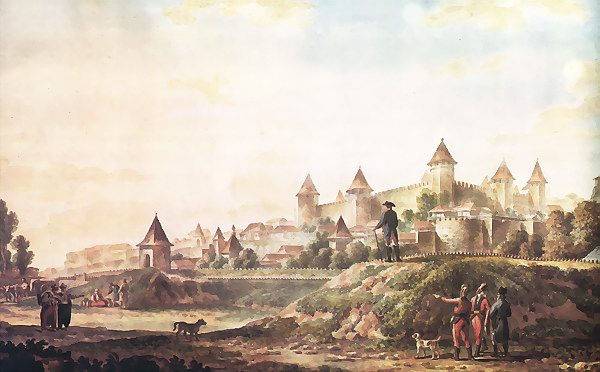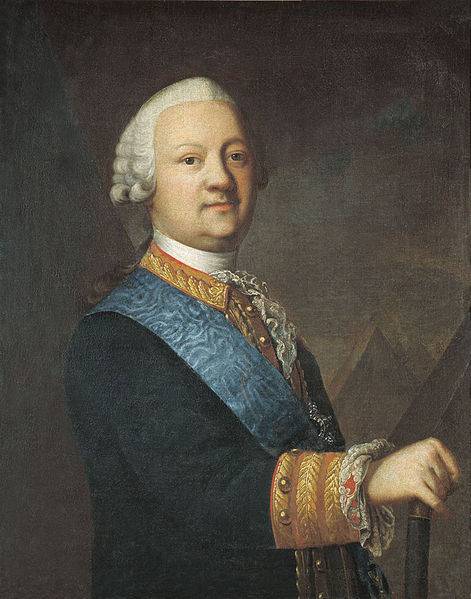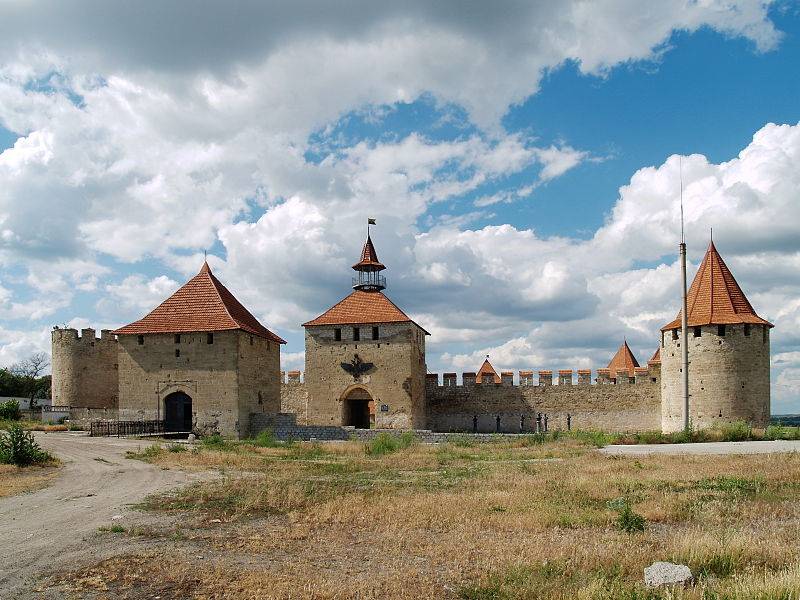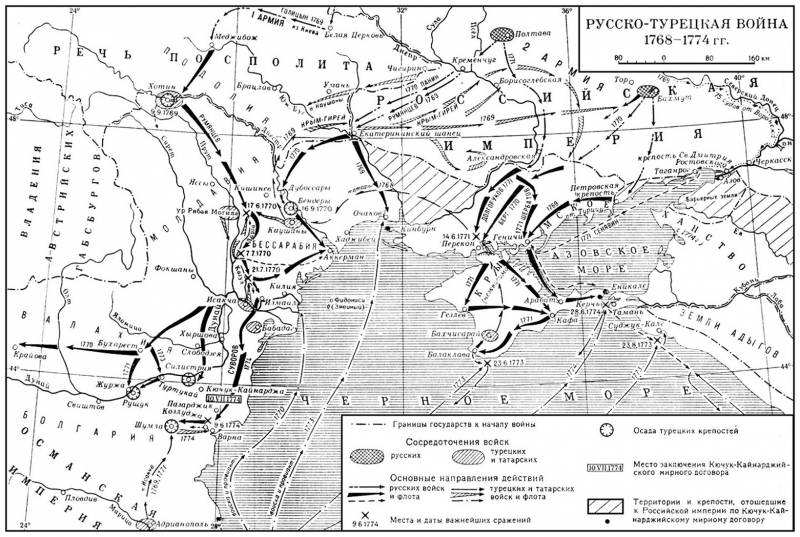Bloody assault on "unapproachable" Bender

M. M. Ivanov. View of a fortress in Bendery (1790)
250 years ago, on September 16, 1770, after a two-month siege, Russian troops under the command of Count Panin stormed the Turkish fortress of Bender. The Turkish garrison was destroyed: about 5 thousand people were killed, the rest were taken prisoner. It was one of the bloodiest battles of this war.
2 Army Offensive
The 2nd Russian army under the command of General Pyotr Panin (40 thousand soldiers and about 35 thousand Cossacks and Kalmyks) during the campaign of 1770 operated in the Bendery, Crimean and Ochakov directions. Panin's main corps was aimed at Bendery, Berg's corps on the left bank of the Dnieper - against the Crimea, and Prozorovsky's corps - against Ochakov. Also, part of the troops guarded the rear and the coast of the Azov Sea.
In the spring of 1770, the 2nd Army began to move. In June, the Russians crossed the Bug, in early July - the Dniester. The cautious commander paid special attention to ensuring communications with his base Elizavetgrad and built a number of fortifications along the way. At each overnight stay, following the example of Tsar Peter I, he erected a redoubt. Also, great attention was paid to supply. The troops did not need anything. After crossing the Dniester, Panin took care of fortifications to protect the crossing and sent light troops to Bender. On the left bank of the Dniester, a detachment of Major General Kamensky was sent to besiege the Turkish fortress from this bank. Felkersam's detachment, previously stationed in Dubossary, also passed under his command. On July 6, after crossing the river with siege artillery, Panin set out for Bender. Having learned about the approach of Russian troops, the Turkish garrison in Bendery began to send detachments on both sides of the Dniester. Our forward detachments defeated the enemy. The Ottomans fled to the fortress.
The beginning of the siege
On July 15, 1770, Panin's army reached Bendery. Russian troops numbered over 33 thousand people. The Turkish fortress was of strategic importance: it stood on the elevated bank of the Dniester near its confluence with the Black Sea. The fortress was built in the 18th century on the model of European citadels, it was divided into upper and lower parts and the citadel itself, was surrounded by a high earthen rampart and a deep ditch. Bender was one of the most powerful fortresses of the Turkish Empire. Therefore, the Bendery fortress was called "a strong castle in the Ottoman lands." The Ottoman garrison numbered about 300 thousand people, led by the seraskir Mohammed Urzhi Valasi. Among the infantry were many handy janissaries. There were over XNUMX guns on the walls.
Count Panin approached Bendery on the right, and Kamensky - along the left bank of the Dniester. In the first hour of the day, Russian troops in five columns approached the fortress at the distance of a cannon shot. The Turks fired heavy artillery, but the effect was practically zero. When the Russian columns reached the places where they were assigned to set up camps, the Turks made a strong sortie (up to 5 thousand people of infantry and cavalry). They attacked our cavalry, which was escorting two right-flank columns. The superiority of the enemy forced our cavalry to retreat. The commander sent to the aid all the cavalry from the three left-flank columns. He also sent there from the left flank 2 battalions of grenadiers and 4 battalions of musketeers. The battle had been going on for an hour and a half, when reinforcements arrived and struck the enemy from three sides. The Ottomans were immediately overturned and fled to the fortress. The Turks lost several hundred people killed and wounded. Our losses are more than 60 people.
Panin could immediately throw troops into the assault, trying to defeat the demoralized enemy. However, there were rumors about a plague epidemic in Bendery. Therefore, the Russian commander feared decisive action. Panin sent letters to the Bendery seraskir, the garrison and citizens, demanding to surrender the fortress, promising mercy, otherwise he threatened ruin and death. There was no answer. To embarrass the enemy, Panin informed the Ottomans about the defeat of the Turkish army at the Battle of Larga.
In order to better surround the fortress and prevent its communication with the outside world, Panin sent out patrols of Cossacks and Kalmyks. On the night of July 19, the construction of the 1st parallel began - a trench adapted for defense during the siege of the fortress. By dawn it was basically ready, with 25 cannons deployed there. When the Turks saw the Russian fortifications, they were alarmed and on July 20 they fired artillery all day. But the Turkish fire was of little use. On the night of July 21, the trench was deepened, 2 batteries were arranged for 7 siege guns and 4 mortars. On the afternoon of the 21st, Russian batteries fired heavily on the enemy fortress and set fire to the city several times. The Turks responded with heavy fire, but fired poorly. Under pressure from the Russians, the Ottomans burned the suburb and left the advanced fortifications. Part of the fortifications on the night of the 22nd our troops occupied and created the 2nd parallel. At dawn, the Turks made a sortie, but they were easily repelled. The counterattack was led by Colonel Felkerzam with the jaegers. The Bendery fortress was shelled again, causing a series of fires. The firing of cards from Kamensky's cannons from the left bank of the Dniester prevented the enemy from receiving water; Fugitives from Bender reported high casualties and significant damage. However, the Ottomans stubbornly defended themselves.

Panin in the 1760s. Hood. G. Serdyukov
Deterioration of the fortress
On the night of 23 July, siege work continued. On the morning of the 23rd, the Turks again made a sortie, but it was repelled by a counterattack of the gamekeepers led by Felkerzam and Kamensky (at that time he arrived on the right bank). Further engineering work continued: new batteries were erected, redoubts, trenches were dug, etc. The siege work was successful. The Turks continued to resist desperately. They hoped that the Grand Vizier and the Crimean Khan would destroy the 1st Russian Army of Rumyantsev and help Bendery. However, these hopes were dashed: on July 25, news came about the defeat of the Turkish army at Cahul on July 21. In sight of the enemy garrison, the Russians solemnly celebrated this victory. In the evening, the fortress was fired upon from all guns.
Nevertheless, the Bendery fortress continued to resist. Its chief, Mohammed Urzhi-Valasi, died (possibly poisoned), and Emin Pasha took his place. Panin informed the new commandant about the defeat of the vizier at Cahul and about the deposition of part of the Crimean Tatars from Turkey. Emin Pasha did not fold weapons... The Russian batteries were getting closer and closer to the fortress, their fire became more effective. The Turks responded weaker and weaker, saving ammunition. They continued to make sorties, but they were repelled by the covering troops, which were supported by the rangers. On July 30, the 3rd parallel was laid. At night, the Ottomans made a strong sortie and attacked the workers. Strong rifle and canister fire did not stop them. Then our troops hit with bayonets, the enemy fled.
The situation of the Bender garrison was getting worse. The city was subjected to constant shelling, there was a lack of water and ammunition. The stench from the dead was in the streets. Panin again offered the Turks change, but did not receive a positive answer. Emin Pasha, dissatisfied with the behavior of the troops, threatened punishment to anyone who dared to retreat before the Russians. On the night of August 1 and 2, the Ottomans made strong attacks, but their attacks were repelled. In these battles, Major General Lebel, who led the troops in the trenches, received a mortal wound. The Turks were unable to stop the siege work. They were continued. In the future, the Turks continued to make sorties, but they became weaker and weaker. On August 8, another heavy bombardment of the fortress was made (over 2100 shots were fired). The Turks tried to respond, but many of their guns were suppressed. Fugitives from Bendery reported heavy casualties, but stated that no matter what, the garrison was still ready to defend itself to the last. Later, seeing that the shelling of the city did not lead to the surrender of the enemy, Panin ordered to take care of the shells. Now no more than 200-300 shots were fired per day.
At the same time, our troops were conducting underground mine work in order to blow up enemy fortifications. The Turks carried out countermine work, but unsuccessfully. Attempts to blow up our underground structures have failed. However, the rains slowed down the work. They forced him to constantly correct the work already done. Combat activity has dropped significantly. Only on 22 August did the Turks make a major sortie. When the mine work came to an end, Count Panin began to prepare an assault. The chiefs of the storming companies were appointed, among them were Kutuzov and Miloradovich. It is interesting that Emelyan Pugachev took part in the siege of Bender in the rank of cornet. From the 23rd, the activity of the Russian artillery increased, now up to 500 rounds were fired per day.
The Turks did not give up. At dawn on August 29, they detonated a mine and launched a powerful attack. Despite the strong canister fire, the Turkish brave men broke into the forward fortifications. But in recent days they have had more troops than usual. The grenadiers counterattacked and drove the enemy back. Our losses in this battle amounted to over 200 people. Again, the hostile explosion did not harm us. The lack of ammunition began to be felt, and due to the continuation of the siege, which lasted longer than planned, the shells again began to save (about 100 rounds per day). A reward was announced for the kernels collected in the field. But that was not enough. We started delivering new ammunition from Khotin, Akkerman, Kiliya and Izmail. The need for shells was so great that all the generals and officers gave their horses for this.
Only on September 3, to conceal the preparation of the assault, the shelling of Bender was increased to 600 rounds. At night, a mine was blown up under the glacis - a gentle earthen embankment in front of the outer moat of the fortress. The Turks immediately rushed to the attack, but were repelled by fire and bayonets. The fight was fierce. The enemy suffered serious losses, our damage was more than 350 people. On the night of September 6, another mine was blown up, a large crater was occupied and became a fortification.
"With fire, thunder and sword ..."
Both sides were preparing for the last decisive battle. The fugitive from the fortress reported that the Bendery Pasha took an oath from the soldiers to fight to the last extreme. The Russian commander decided to launch the assault on the night of September 15-16, 1770. The grenadiers, who were at the forefront of the attack, were divided into three columns under the command of Colonels Wasserman, Korf and Miller. Rangers and musketeers were in reserve for the assault columns. The right flank was commanded by General Kamensky, the left - by Count Musin-Pushkin. The rest of the troops had to support the success of the attacking columns. On the right flank were the infantry under the command of General Elmpt and the cavalry of Vernes, on the left - all the volunteers.
Before the start of the assault, our artillery, under the command of General Wolfe, opened heavy fire. At 10 o'clock in the evening on September 15, a powerful mine (400 pounds of gunpowder) was detonated. The troops went on the attack. The Turks opened heavy fire, but fired poorly in the dark. Panin, noticing that our troops had entered the rampart, sent Colonel Felkersam's rangers to support the left flank, Larionov and Odoevsky with troops from the Elmpt division to the right. As soon as the middle column began to move, Colonel Miller was killed, the soldier was led by Lieutenant Colonel Repnin. Russian soldiers quickly overcame all obstacles: they forced the moat at the foot of the glacis, a double palisade on the ridge of the glacis, the main fortress moat. Then the stairs were attached to the rampart. The soldiers rushed onto the shaft. The flank columns also successfully burst onto the shaft.
Fierce hand-to-hand fighting ensued. The Turks fought with great ferocity. From the ramparts, the battle spread to the streets and houses. For every step our troops had to pay a high price. But our warriors cut their way to the citadel. The units received reinforcements, more and more troops entered Bender. Almost all of the army's infantry took part in the battle. To cover the rear from a potential enemy attack, Panin occupied the trenches with dismounted carabinieri, hussars, etc. The bloody battle lasted all night and all morning. The city was on fire. Some of the buildings were set on fire by our artillery to distract the enemy and facilitate the attack. During the battle on the streets, the Turks fiercely defended themselves in large buildings, and Panin ordered them to be set on fire. Then the Ottomans themselves, hoping to stay in the citadel, began to set fire to houses so that they would not fall into the hands of the infidels and the fire disrupted the assault on the castle. The ongoing battle did not allow our soldiers to put out the fire.
The Ottomans, wanting to stop the movement of our troops, made a last sortie. Up to 1,5 thousand of the best cavalry and 500 people of infantry came out of the gates facing the river, and gathered to strike in the rear of our left flank or along the carts, where there was a small party of sick and non-combatants. Several squadrons of our cavalry on the left flank attacked the enemy, but seeing the enemy's weakness, the Turks bypassed them. They were going to attack the train. The brave Colonel Felkerzam saw the danger from the rampart, returned with his huntsmen and rushed to protect the convoy. Other commanders followed suit. General Elmpt sent to the carts everyone who was at hand, volunteers, dismounted cavalrymen, Cossacks, who were at various posts around the fortress. They even turned the cannons from the rear parallel and opened fire with buckshot. The Turks were attacked from all sides. They fought bravely, but their plan failed. Seeing the failure of the operation, the Ottomans tried to break through in the direction of Ackermann, but it was too late. All the cavalry was destroyed, part of the infantry surrendered.
The destruction of this unit was the last straw for the Bender garrison. At 8 o'clock in the morning, the Turks offered to surrender. 11,7 thousand people laid down their arms, during the assault 5-7 thousand people were killed. 348 guns were taken from the fortress. All the prisoners and townspeople were taken out into the field, the town and castle were on fire. The fire raged for three days. All buildings were burned down. There were smoking ruins on the site of the recently rich city. Bender has lost the proud title of an impregnable fortress.
During the assault, the Russian army lost over 2500 people killed and wounded. And in total during the siege and assault, Panin's army lost over 6 thousand people (almost a fifth). The death of the city and heavy losses made an unfavorable impression in Petersburg and greatly reduced the value of the acquisition, bought so dearly. Catherine II said: "Than to lose so much and gain so little, it was better not to take Bender at all." But she got excited. The fall of the strategic Bendery fortress hit Turkey hard. The Turkish authorities declared mourning for this. After the fall of Bender, the Dniester-Prut interfluve came under the control of the Russian army. In addition to the actual hostilities near Bendery, Ochakov and the Crimea, on behalf of the government, Panin conducted negotiations with the Tatars throughout the year. As a result of these negotiations and the military successes of the Russian Empire, the Tatars of the Budzhak, Edisan, Edichkul and Dzhambulak hordes decided to leave the Port and accept the patronage of Russia.

Bendery fortress

Information